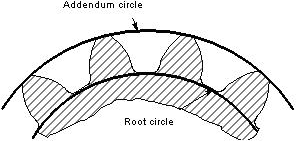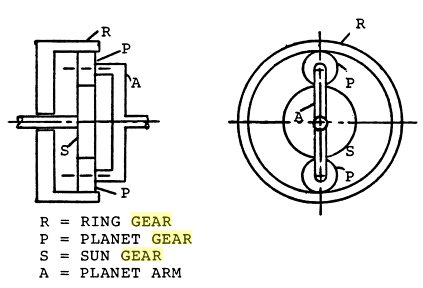Thirty Questions on Gear in Power Transmission
Question.1. Define pitch circle.
Answer.

Fig.1
A circle radius of which is equal to the distance from the gear axis to the pitch point. It is the imaginary circle that rolls without slipping with a pitch circle of a mating gear. These are the outlines off the imaginary smooth roller or friction discs in every pair of mating gears. Many important measurements are taken on and from this circle. Pitch circle is shown in Fig. 1.
Question.2. Define pitch point.
Answer.
It is the point of tangency of the two pitch circles or a pitch circle and a pitch line (Figure.1). It lies on the line of centers.
Question.3. Define circular pitch.
Answer.
It is the distance measured on the pitch circle from a point on one tooth to a corresponding point on the next tooth as shown in the figure given below.

Fig. 3
Mathematically,




The angle subtended by the circular pitch at the centre of the pitch circle is called pitch angle.
Question.4. Define module.
Answer.
It is the ratio of the pitch circle diameter to the number of teeth. Mathematically,


Question.5. Define diametral pitch.
Answer.
It is the number of teeth on the gear per unit of the pitch circle diameter. Mathematically,

Question.6. Define addendum circle.
Answer.

Reference : http://upload.wikimedia.org/wikipedia/commons/7/75/Root_circle.JPG
Fig. 6. Addendum Circle and Root circle
It is the circle passing through the top of the teeth and is concentric with the pitch circle as shown in the figure. It is also called tip circle.
Question.7. Define addendum.
Answer.
It is the radial distance from the pitch circle to the top of the tooth. Its standard value is one module (Figure.7 Gear).
Fig.7. Gear
Question.8. Define dedendum circle.
Answer.
It is the circle drawn through the bottom of the teeth and is concentric with the pitch circle. Dedendum circle is shown in the (Fig. 6. Addendum Circle and Root Circle).It is also called root circle.
Question.9. Define dedendum.
Answer.
It is the radial distance from the pitch circle to the bottom of the tooth. Its standard value is 1.157m (Figure.7 Gear).
Question.10. Define clearance.
Answer.
It is the difference between dedendum and addendum.

(Figure.7 Gear)
Question.11. Define backlash.
Answer.

Fig. Backlash
It is the amount by which the width of a tooth space exceeds the thickness of the engaging tooth on the pitch circles.

Question.12. Define top land.
Answer.

Fig.12. Gear Nomenclature
It is the surface of the top of the tooth as shown in the Fig.12. Gear Nomenclature.
Question.13. Define face width.
Answer.
It is the length of the tooth parallel to the gear axis as shown in Fig.12. Gear Nomenclature.
Question.14. Define face.
Answer.
It is the tooth surface between the pitch circle and the top land as shown in Fig.12. Gear Nomenclature.
Question.15. Define flank.
Answer.
It is the tooth surface between the pitch circle and the bottom land as shown in Fig.12. Gear Nomenclature.
Question.16. Define bottom land.
Answer.
It is the surface of the bottom tooth between adjacent fillets as shown in Fig.12. Gear Nomenclature.
Question.17. Define fillet.
Answer.
It is the curved portion of the tooth flank at the root circle as shown in Fig.12. Gear Nomenclature.
Question.18. Define total depth.
Answer.
It is the radial distance between the addendum circle and the dedendum circle of a gear. It is equal to the sum of addendum and the dedendum as shown in Fig.7. Gear. It is also represented as Whole depth.

Question.19. Define working depth.
Answer.
It is the maximum depth in which a tooth penetrates into the tooth space of the mating gear as shown in Fig.7. Gear .

Question.20. Define Pressure angle.
Answer.
The pressure angle exists between the tooth profile and a radial line to its pitch point. In involute teeth, it is defined as the angle formed by the radial line and the line tangent to the profile at the pitch point.

Fig. (a)
Here  . Therefore,
. Therefore,  is also the pressure angle.
is also the pressure angle.

Fig. (b)
This figure (b) indicates the meshing of a gear A and a gear B at the pitch point. At the pitch point, the gear A is pushing the gear B. The pushing force acts along the common normal of the gear A and the gear B. The pressure angle can be described as the angle between the common normal and the line tangent to the reference circle. The standard pressure angles are  .
.
Question. 21. Define gear ratio.
Answer.
The ratio of the number of teeth on gear to that on the pinion is known as a gear ratio.



Question.22. Define speed ratio of gear device.
Answer.
It is the ratio of the angular velocity of the driver gear to that of driven gear.

Question.23. State law of gearing.
Answer.
It states that the common normal at the point of contact always passes through pitch point.
Question.24. Name different forms of gear teeth.
Answer.
(i) Involute teeth.
(ii) Cycloidal teeth.
Question.25. Define gear train.
Answer.
A gear train is a combination of two or more gears used to transmit power from a driving shaft to some driven shaft.
Question.26. Name different types of gear trains.
Answer.
1. Simple gear train,
2. Compound gear train.
3. Reverted gear train.
4. Epicyclic or planetary gear train.
Question.27. What is a simple gear train?
Answer.
A simple gear train is a series of gears capable of receiving and transmitting motion from one gear to another. In this train, there is only one gear on each shaft.

Fig. Simple Gear Train
Question.28. What is a compound gear train?
Answer.
A compound gear train consists of a series of gears connected in such a way that two or more gears rotate about an axis with the same angular velocity i.e. there are more than one gear on a shaft.

Fig. Compound Gear Train
Question.29. What is Reverted gear train?
Answer.
Reverted gear train are the compound gear train in which both the axis of the driver and the driven shaft are co-axial. A reverted gear train is shown in figure given below, it should be noted that gear 1 and the gear 4 are mounted on the driver and the driven shaft respectively, whose axes are collinear. Gear 2 and gear 3 are mounted on the intermediate shaft. In an reverted gear train the pitch radii of the gear 1 and 2 must be equal to that of gear 3 and 4 (i.e.,![]() ).
).

Fig. Reverted gear train
Question.30. What is an epicyclic or planetary gear train.
Answer. A planetary gear train is a kind of gear train in which one more gears rotates about a central or sun gear as shown in figure.

The main advantage of the epicyclic gear train is its capability of providing large speed reduction with small number of gears with moderate size. The use of this gear train is increasing in high-power transmission systems, notably in turbo generation plant.

One Response to “Thirty Questions on Gear in Power Transmission”
rudranush raj
Please send me the mine machinery questions and solutions